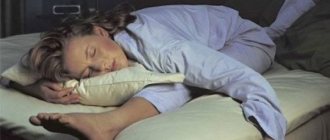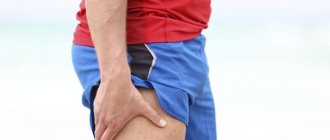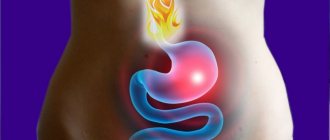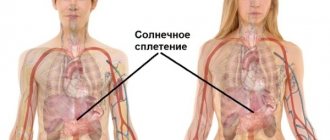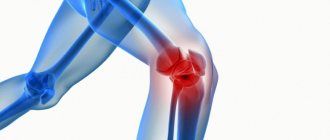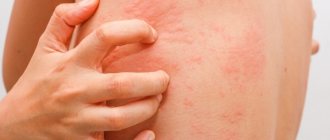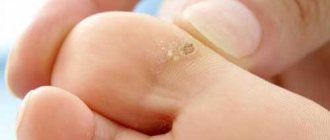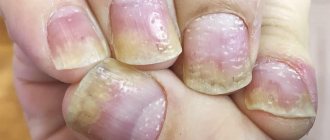Heavy legs in the morning is one of the most common problems for some people. Usually this is severe discomfort or heaviness that spreads to different parts of the legs. Many different factors can cause heavy legs to develop in the morning. Heaviness in the legs is usually accompanied by pain or cramps. Feeling tired in the lower extremities without other accompanying symptoms is usually not a cause for concern, but it is important to pay attention to your body. Especially when there are other symptoms besides severity.
A list of some possible reasons that provoke the development of heaviness in the legs in the morning:
- overtraining - during excessive loads, more than usual, and with insufficient rest, heaviness in the lower extremities can develop. The more you train, the more time you need to rest;
- Insufficient physical activity can provoke the development of heaviness in the legs. When the muscles in the legs are not exercised regularly, they become more prone to muscle spasms. The sudden shift or movement of the legs, which often occurs when a person wakes up, leads to muscle strain, which leads to the development of heaviness in the lower extremities. This condition develops in the morning because the leg muscles are inactive during the night, leading to the development of cramps. If you spend a long time in a sitting or lying position, you need to exercise for five minutes every hour. And while in a lying position, it is necessary to give the lower extremities an elevated position, which improves blood circulation in the lower extremities;
- hypokalemia – occurs when the level of potassium in the blood is below normal. This can lead to fatigue, weakness, and leg cramps. Hypokalemia can be triggered by certain medications and diseases;
- poor blood circulation in the legs. Poor blood circulation often develops in the lower extremities, as the outflow of blood is disrupted, which is associated with vascular disease.
- pregnancy – causes changes in hormone levels, increased intra-abdominal pressure, which leads to increased pressure in the veins of the lower extremities. Pregnant women are often bothered by heaviness and spasms in the lower extremities.
- Nerve irritation – This occurs when muscles, tendons and ligaments put pressure on nerves. This can happen when you sleep in certain positions that put pressure on the soft tissue around the tense nerves.
- dehydration caused by poor diet or excessive exercise leads to a lack of fluid in the body, which can cause heaviness in the lower extremities;
- Some types of medications can cause morning heaviness in your legs.
Doctors at the Yusupov Hospital have extensive experience in diagnosing and treating diseases that can lead to the development of heaviness in the legs in the morning. By paying special attention to each patient in collecting complaints and having the most modern diagnostic equipment at their disposal, specialists can make an accurate diagnosis and begin treatment in the shortest possible time. Using only advanced treatment methods that have proven effective in the Russian Federation and abroad allows you to quickly restore lost functions and return to normal everyday life.
Causes
Let's look at the most common causes of heavy legs:
- puberty, pregnancy (especially in the third trimester) and childbirth, menopause (menopause);
- heredity;
- congenital weakness of connective tissue and vein walls;
- poor diet, alcohol consumption and excess body weight;
- forced prolonged sitting or standing position (leads to venous stagnation);
- bruises of the knees, ankles and leg injuries;
- disruption of the endocrine system (dysfunction of the thyroid gland, malfunction of the pancreas, dysfunction of the adrenal glands);
- taking antihypertensive, hormonal, hypoglycemic and anti-inflammatory non-steroidal drugs (these medications can have a side effect, the essence of which boils down to the accumulation of fluid in the soft tissues of the extremities);
- stress leading to nervous disorders (as changes occur in the nerve endings of the veins, which negatively affects tone);
- seasonal exacerbations.
Sometimes years pass before a person begins to notice that heaviness in the legs has become a constant companion. All of the above factors serve as serious prerequisites that can contribute to the development of a disease such as varicose veins.
!
Varicose veins or varicose veins of the lower extremities are a slowly progressive pathological expansion of the saphenous veins of the legs.
Sooner or later, the disease will make itself felt and will cease to be only an aesthetic problem, leading to deep damage to the veins. Then the treatment will become more serious and lengthy than simple prevention, which would help avoid serious consequences at the early stage of development of varicose veins.
Ineffective functioning of the deep veins leads to chronic blood stagnation and the appearance of characteristic symptoms of “heavy legs”:
- evening and night cramps in the calf muscles;
- swelling regularly occurring in the evening or night and disappearing in the morning (ankles and feet, and then legs);
- a constant feeling of heaviness in the legs during and after physical activity (when climbing stairs and after running, for example);
- burning in the veins of the legs, especially after a long period of standing;
- feeling of “bloating” and numbness in the legs;
- foot pain;
- the appearance and disappearance of spider veins and dark spots depending on the position of the legs.
Diagnosis
Before starting to treat a particular disease, a comprehensive examination is required. The following procedures may be prescribed:
- Carrying out angioscanning. During the study, the doctor has the opportunity to study the condition of the vein along its entire length, to identify the exact location of the narrowing of the lumen and the formation of a blood clot.
- Ultrasound examination of the pelvic organs.
- Face-to-face consultation with an endocrinologist, blood test for thyroid hormones.
When faced with the problem of heavy legs, you should refrain from self-medication and, at the first sign of a problem, consult a doctor.
Heaviness in the legs when walking
What does heaviness in the legs indicate when walking:
- Pathologies of the heart and vascular system: cardiomyopathy, pericarditis, chronic heart failure, thrombophlebitis. All of the above diseases lead to impaired blood circulation and the occurrence of pain, heaviness in the calves, which is constantly pulsating in nature, intensifying when walking;
- Kidney pathologies: acute and chronic renal failure, nephrotic syndrome. As a result of the pathology, there is a delay in the removal of fluid from the body and the development of edema against this background, and they can already be localized throughout the body, in particular in the lower extremities;
- Spinal pathologies: sciatic neuralgia (sciatica), lumbago (Lumbago) and other diseases are directly related to leg diseases:
- With sciatica, pain almost always occurs in the ankle, knee and hip joints, because The sciatic nerve runs along the back of the leg. Many patients confuse these symptoms with ordinary fatigue that occurs after heavy physical labor;
- With lumbago, there is a sharp pain in the lumbar back. It is accompanied by unbearable heaviness in the leg because the femoral nerve is affected.
!
If you regularly notice such symptoms, you should contact a specialist as soon as possible and identify the cause.
Advanced diseases are much more difficult to treat than those detected at an early stage of development.
is not responsible for the accuracy of the information presented in this video clip. Source - Everything will be fine
Treatment
Help before diagnosis
To get rid of heaviness in the legs, patients are advised to choose comfortable shoes and use orthopedic insoles. If you need to spend the whole day in a standing position (hairdressers, salespeople, cooks), you need to wear compression stockings that help reduce venous stagnation. It is necessary to maintain body weight within normal limits so as not to create additional stress on the feet.
To improve peripheral blood circulation and increase the tone of venous vessels, exercise (swimming, cycling) is useful. The amount of strength and static training, which increases the deposition of blood in the veins, should be reduced. Lifestyle changes play an important role: increasing daily activity, frequent walking.
Conservative therapy
Treatment of vein diseases in clinical phlebology begins with medications: taking antiplatelet agents, phlebotonics, applying ointments and creams to areas of the skin with trophic lesions. B vitamins and desensitizing drugs are indicated as general tonic agents. In rare cases, the treatment regimen is enhanced with corticosteroid hormones.
Therapy is supplemented with elastic compression (bandages, stockings) to maintain venous vessels in tone and reduce heaviness in the legs. For the treatment of varicose veins, compression sclerotherapy is widely practiced - the injection of drugs into the veins that cause gluing of the vascular walls and reduce venous stagnation. After the manipulation, pain and swelling of the legs are eliminated.
To reduce edema in cardiac and renal pathologies, diuretics are used. With constant use of the medicine, excess fluid is removed, shortness of breath and heaviness in the legs are eliminated. For heart failure, beta blockers, glycosides and other drugs are additionally prescribed to improve the strength of myocardial contractions.
Surgery
For varicose veins, several types of surgical interventions are performed:
- minimally invasive (photocoagulation, laser removal of spider veins, radiofrequency coagulation);
- classical (phlebectomy, Troyanov-Tredelenburg operation).
For patients with lymphedema, lymphovenous shunting, tunneling, and autotransplantation of the tissue lymphoid complex are recommended.
Flat feet are treated by experienced orthopedic traumatologists. In the stage of planovalgus foot, resection of protruding areas of bones, tendon transplantation, and removal of heel spurs are performed. For patients with severe transverse flatfoot, resection of hallux valgus followed by plastic surgery of the articular capsule is indicated.
What to do and how to treat?
Like the treatment of any other ailment, eliminating heaviness and pain in the veins of the legs should first of all be aimed at eradicating the underlying disease.
Expert opinion
In some cases, consulting a phlebologist is not enough to make a diagnosis. To find out the cause of heaviness in the legs, additional research may be required: examination by a cardiologist and endocrinologist, coagulogram, duplex scanning of blood vessels.
Vascular surgeon, phlebologist
Osipova Ekaterina Yakovlevna
If, after an examination, the doctor diagnoses you with “varicose veins of the lower extremities,” then you should prepare yourself for the fact that the recovery process can be long and laborious. But if you do not treat varicose veins, then there is a high risk of complications: thrombosis, thrombophlebitis, trophic ulcers and eczema.
The duration of treatment directly depends on the stage at which the disease is detected. Naturally, the sooner you start treatment, the more effective it will be. As medical practice shows, a greater effect is achieved by complex treatment that combines the correct sequence of various methods for eliminating heaviness in the veins of the legs.
Treatment can be conservative or surgical:
- Non-surgical (conservative) treatment is used: in the early stages of the disease; if there are contraindications to surgical intervention; is mandatory in the postoperative period. The concept of “conservative treatment” includes reducing symptoms through moderate physical activity, wearing elastic underwear, physical therapy and medications. Often, all of the above methods of conservative treatment are used together, thereby achieving maximum effect. At all stages of development of varicose veins, the use of venotonic agents (sometimes entire complexes) is recommended. The release form is different: tablets, capsules, creams, gels, tonics, ointments. The composition of these drugs mainly includes tonic substances of plant origin, the active natural components of which, for the most part, do not have adverse reactions. Venotonics have a positive effect on the walls of the veins, which is manifested by a decrease in the painful symptoms of varicose veins.
- If we resort to medical statistics, then in Russia alone about 35 million people suffer from varicose veins, and more than 1.5 million people need surgical treatment every year. Surgical treatment methods are used depending on the degree of damage to the veins and the severity of the disease. If conservative treatment is ineffective, then in such cases the following types of treatment are relevant:
phlebectomy
(surgical removal of varicose veins);
sclerotherapy
(introduction of a sclerosant into a dilated vein, which causes the walls of the vein to stick together and blood flow through it becomes impossible);
laser coagulation
(destructive laser action on the vein wall, resulting in thermal ablation of the venous lumen).
Only a doctor can determine which treatment method is right for you.
Diagnostics
Considering that most cases of heaviness in the legs are associated with venous circulation disorders, an examination by a phlebologist is necessary. Often, a preliminary diagnosis is made during an objective examination, when varicose veins, edema, hyperpigmentation, and other typical manifestations are detected. To clarify the diagnosis and identify other etiological factors causing heaviness in the limbs, the following is carried out:
- Doppler ultrasound of veins
Duplex scanning of vessels is used to study the anatomical structure of the venous bed, assess the tone and function of the valves. Chronic venous insufficiency is manifested by slow blood flow, pathological blood reflux, and phlebothrombosis. - Rheovasography of the lower extremities.
A modern diagnostic method that shows even minor changes in hemodynamics and microcirculation. Based on the results of the study, the doctor gives an opinion on the condition of the peripheral veins during stress tests and at rest. Sometimes venography is prescribed for additional examination of blood vessels. - Lymphangiography.
Visualization of lymphatic vessels using a contrast agent is required to determine their patency and the functioning of the valve apparatus. The difference in diameter in different parts of the vessels and uneven contrast indicate pathology. For dynamic assessment of lymph circulation, lymphoscintigraphy is indicated. - X-ray of the foot.
If flat feet are suspected, an orthopedic traumatologist joins the diagnostic search. Based on X-ray images, the doctor measures the height of the arches and pathological angles between bone structures, establishes the type and severity of the disease. The diagnosis is clarified using plantography. - Additional research
. To diagnose osteochondrosis, which causes heaviness in the legs, an x-ray or computed tomography scan of the spine is performed. To confirm cardiac diseases, ECG, echocardiography, and chest X-ray are recommended. Survey and excretory urography are informative for excluding renal causes of edema.
Phlebologist consultation
Severity not associated with pathologies
An abnormal manifestation in the lower extremities is not always evidence of disease. It can arise as a result of:
- the influence of unfavorable weather conditions on a person (extreme heat leads to a drop in vascular tone, their dilation, and the accumulation of excess fluid);
- low physical activity, which leads to the destruction of normal blood circulation;
- hormonal imbalances caused by the menstrual cycle in women, taking contraceptives;
- intense sports training, muscle strain, heavy work.
You can get rid of a negative phenomenon if the factors that caused its occurrence are eliminated.
General recommendations
There are general recommendations that can help you get rid of the feeling of heaviness and fatigue in the lower extremities. These include:
- When a particular pathology is identified, it is necessary to direct efforts to eliminate it. To do this, you must follow the doctor’s instructions and take the prescribed medications in a timely manner.
- Women are advised to refrain from taking hormonal contraceptives. Such medications can only be used if there are objective indications for use and under the supervision of the attending physician.
- Moderate physical activity helps prevent congestion, trophic and lymphatic disorders. Performing therapeutic exercises, walking, and swimming in the pool are recommended for patients who are faced with the problem of heaviness in the legs.
- It is necessary to avoid excessive heat loads: visiting a bathhouse, sauna, solarium, and refrain from prolonged exposure to direct sunlight. Also, excessive hypothermia of the body, including the lower extremities, should not be allowed.
- Representatives of the fair sex are advised to avoid wearing tight shoes and excessively high heels. The recommended heel height is no more than 3-5 centimeters.
- It is recommended to give up the habit of sitting with your legs crossed once and for all. This position causes severe blood stagnation, which provokes the development of complications in the form of a feeling of heaviness and pain.
- It is necessary to carefully monitor your diet. You will have to abstain from smoking, drinking alcohol, fatty foods, and spices. It is recommended to consume vegetable oils, fresh fruits and vegetables.
People with excess body weight are recommended to focus their efforts on weight loss.
Therapy with folk remedies
Treatment with folk remedies helps to quickly and effectively cope with feelings of fatigue and pain. You can use the following recipes:
- Make foot baths with the addition of a decoction of linden, chamomile, oak bark, mint and nettle. All components are mixed, poured with water and brought to a boil. After this, cool to a comfortable temperature and take baths.
- In order to quickly eliminate the feeling of heaviness in the legs, it is recommended to apply compresses. Wrap several ice cubes in a small piece of fabric and rub your feet with massage movements from bottom to top.
- The most effective and proven remedy that normalizes blood flow and, as a result, eliminates all unpleasant symptoms in the legs is to take a horizontal position and raise your legs above the level of your heart.
- To eliminate the feeling of fatigue, you can periodically do light self-massage using products that include horse chestnut extract, essential oils of mint, juniper, cypress and lavender. The massage should be done with careful movements, from the feet to the hips.
- Baths with the addition of apple cider vinegar, sea salt, decoctions of medicinal herbs and essential oils have a pronounced relaxing effect. Similar procedures can be carried out after a long day of work.
You need to take care of your own legs, as they are subject to enormous physical stress. Preventive measures in the form of moderate physical activity, giving up bad habits and adjusting the diet will help avoid the development of serious complications and will have a positive therapeutic effect.
